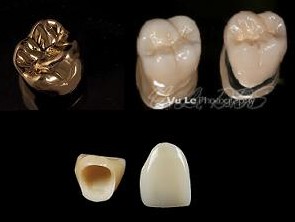Crowns or caps have had over a century of success in saving teeth. Fillings are used to restore tooth structure lost to decay or fractures, however, they do not cover and protect the teeth from fracturing like crowns do. There are three major varieties of crowns – cast metal, porcelain-fused-to-metal, and all porcelain.
Cast crowns are usually made of gold. They have the longest track record and usually last the longest of the group. This is because there is no veneering surface to fracture and gold is a very tough, inert substance. I have personally observed crowns that have been in patients’ mouths for well over fifty years. The drawback is that they look like gold teeth. The other two varieties have a porcelain outer layer. Porcelain can be constructed to almost perfectly mimic teeth. And the porcelain is extremely tough and color stable. There are still quite a few crowns that I placed over thirty years ago that still look as good now as they did on the day that I put them in. The porcelain is baked onto a metal or porcelain core. The metal can be made much thinner, so it is better for crowns for back teeth. The newer porcelain cores are having very promising results and are excellent for front teeth because light can be transmitted through it giving the crown a natural life-like luster.



